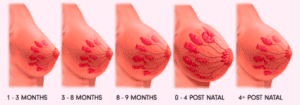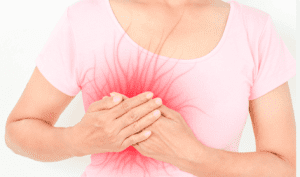Health
Why is My Breast Getting Bigger? Unraveling the Mystery

Last Updated on May 24, 2023 by Nurse Vicky
Why is My Breast Getting Bigger? Unraveling the Mystery
Understanding the Factors Influencing Breast Size
Breast size is a topic of interest and concern for many individuals, both women, and men alike. If you’ve noticed that your breasts are getting bigger, it’s natural to wonder why. In this comprehensive article, we will delve into the various factors that can contribute to breast enlargement.
While it’s important to note that changes in breast size can have underlying medical reasons, we’ll primarily focus on the non-pathological factors. So, let’s explore the possible causes and shed light on the mystery of why your breasts may be increasing in size.
Hormonal Fluctuations and Breast Growth
One of the primary reasons for breast enlargement is hormonal fluctuations. During puberty, a surge in estrogen levels triggers breast development in females.
Similarly, hormonal changes during the menstrual cycle can cause temporary breast enlargement, tenderness, or swelling. Hormone imbalances, such as those experienced during pregnancy or menopause, can also lead to noticeable changes in breast size.
Weight Gain and Its Impact on Breast Size
Weight gain is another common factor that can contribute to an increase in breast size. Breasts contain fatty tissue, and as your body gains weight, it can accumulate in the breast area, causing them to grow larger. This weight-related breast enlargement is typically proportional to overall weight gain.
Breast Tissue Expansion Due to Pregnancy
During pregnancy, a woman’s body undergoes numerous changes, and one of them is breast enlargement. As the body prepares for breastfeeding, the mammary glands increase in size, and the breasts become fuller and more rounded. This natural process ensures that the mother’s body can produce and store milk to nourish the newborn.
Hormone Replacement Therapy (HRT) and Breast Enlargement
Hormone replacement therapy (HRT) is a medical treatment prescribed to alleviate symptoms of menopause or hormonal deficiencies. Estrogen, progesterone, or a combination of both hormones may be administered. HRT can lead to breast growth as it mimics the hormonal changes experienced during pregnancy or puberty.
Side Effects of Certain Medications
Some medications, such as hormonal contraceptives, antidepressants, and certain steroids, can have side effects that include breast enlargement. If you have recently started taking any new medications and noticed an increase in your breast size, it is advisable to consult with your healthcare provider to determine if this is a possible side effect.
Changes in Body Fat Distribution
Each person’s body has a unique fat distribution pattern. In some cases, fat deposits in the breasts may increase, causing them to grow larger. Factors such as genetics and hormonal fluctuations play a role in determining where fat accumulates in the body.
Breast Health Conditions and Tumors
While the previous factors primarily focus on non-pathological reasons for breast enlargement, it’s crucial to be aware of potential health conditions. Some benign breast conditions, such as fibroadenomas or cysts, can cause breast swelling.
However, it’s important not to jump to conclusions and self-diagnose. If you are concerned about changes in your breast size, it is always recommended to seek medical advice for proper evaluation.
Lifestyle and Dietary Influences on Breast Size
Certain lifestyle and dietary factors may contribute to changes in breast size. Consuming a diet high in calories and unhealthy fats can lead to overall weight gain, potentially affecting breast size. Additionally, lack of physical activity and sedentary habits may contribute to weight gain and subsequent breast enlargement.
In addition, estrogen stimulates cell growth in the breast tissues, increasing the size of your boobs.Read on to learn more about these hormonal changes.
Increase in breast size during pregnancy

Women may experience a significant increase in breast size during pregnancy. Some women may experience breast swelling and tenderness during the first few months of pregnancy, and the changes may last well past the delivery of the baby.
Breasts may be swollen and painful for a while, but this is common and is no cause for concern. The hormones that make breasts bigger during pregnancy stimulate the formation of extra fatty tissue and increase blood flow.
They also trigger changes in the chest that prepare the mother to breastfeed her newborn. Several studies have shown that the increase in breast size during pregnancy correlates with a woman’s biological condition and quality.
Women with larger breasts are more likely to have ecologically sensitive male fetuses than women with smaller breasts. However, these associations are not conclusive and women should have regular breast examinations regardless of the increase in breast size during pregnancy. Further studies will be necessary to confirm these findings.
Increase in breast size during menopause

Many women experience increased breast size during menopause. However, many also experience smaller, saggier breasts. Whatever the cause, breast changes are real and you can expect to deal with them. Continue to do regular self-exams. Look for lumps or discharge from the nipple.
As a result, breast size can increase drastically during menopause. Regardless of the size increase, breasts can become sore and puckered, the same as they do before and after a period. As a woman age, estrogen levels drop dramatically. This means that the glandular tissue in the breasts is shrinking .
The resulting fatty tissue is less dense and takes up more space. Some women retain some fatty tissue in their breasts during menopause while others lose it.
These changes may affect your appearance and may warrant medical attention. If you notice these changes, seek medical attention to determine the cause of your breast growth.
Increase in breast size in your 40s

As a woman, you’ve probably noticed an increase in breast size. You can blame menopause for this. The hormone that makes breast tissue pliable is depleted during menopause. The breasts gradually replace the tissue with fat, or involution.
Interestingly, this process does not take place uniformly, and there are lumps and bumps to be aware of. At this age, collagen in the breasts begins to give way, so you should do regular self-checks. A few signs that you should watch for include droopy breasts.
In addition to droopy breasts, some women may develop fluid-filled cysts in their breast ducts. These cysts are harmless and do not pose a risk of breast cancer, but you should consult a doctor if you notice lumps on your breasts that don’t diminish after your period. A doctor can determine if you have a droopy or saggy breast.
Fibrocystic changes in your 40s

If you’ve experienced fibrocystic changes in your breast, you probably already know that this condition doesn’t cause cancer, although the dense tissue found in the area is a risk factor for cancer.
Cysts in the breast typically increase in size about one week before your period, and the symptoms usually disappear after your period starts. They often produce a rash or discharge from the nipple and are often accompanied by increased warmth and dimpling.
Women may notice lumps and/or swelling in their breasts, but the masses are usually asymptomatic and are discovered accidentally during routine breast self-examinations.
When women are in their twenties and early thirties, these changes may be normal. Women in their 20s may notice lumps that feel tender or sore to the touch, which could indicate fibrocystic changes.
Additionally, many ask
Why have my breasts all of a sudden started to feel so full?
There are numerous potential causes of breasts that are painful and heavy. The presence of hormones, being pregnant, or breastfeeding can all contribute to a person’s breasts feeling swollen, heavy, and painful.
Alterations to one’s way of life can alleviate breast pain in many instances. A person should go to the doctor if the pain comes again or if it causes them to feel anxious.
Why do I feel like my breast is getting bigger?
It is likely that breast enlargement is caused by the hormonal shifts that occur during the menstrual cycle. More estrogen is produced at the beginning of the cycle, and it reaches its peak shortly before the middle of the cycle. Because of this, the size of the breast ducts will increase. Progesterone levels reach their highest point around the 21st day
When do breast changes first become noticeable during pregnancy?
Tenderness in the breasts is frequently one of the earliest signs that a woman is pregnant. Breasts may start to hurt, feel heavy, or experience tingling anywhere from one to two weeks after a pregnancy is conceived, as stated by the National Institute of Child Health and Human Development. When you touch the nipples, you could experience sensitivity or even discomfort.
How can you tell if something is wrong with your breast, and what are the symptoms?
Visit a primary care physician if you observe any of the following changes: a modification to the size, contour, or shape of either or both of your breasts.
a change in the appearance or sensation of the skin on your breasts, such as puckering or dimpling, a rash, or redness; this could also refer to a change in the color of the skin. a previously undetected growth in one breast or armpit that takes the form of a lump, swelling, thickening, or rough region.
What kind of discomfort in the breasts is typical during pregnancy?
Breast morphology shifts Your breasts may feel more tingling, full, and sore in the early stages of pregnancy, and you may find that your bra does not fit nearly as well as it did before you became pregnant. Due to the fact that this is associated with hormone changes in your body, it is also possible that you are on the verge of beginning your period.
In the early stages of pregnancy, what area of the breast is most uncomfortable?
In the first few weeks of pregnancy, the nipples can be especially sensitive for many different types of women. They may be so sensitive to the touch that it is excruciating to pat them dry after a shower or to put on a bra (you can skip the bra with complete assurance!). However, acute nipple sensitivity usually disappears after a few weeks have passed.
It is common for normal breast tissue to have a lumpy, nodular texture, and the consistency might differ from woman to woman. Even inside a single woman’s own body, breast tissue can have a varied consistency at various points in a woman’s menstrual cycle as well as at other times throughout a woman’s lifetime.
conclusion
the size of your breasts can be influenced by various factors. Hormonal fluctuations, weight gain, pregnancy, hormone replacement therapy, certain medications, changes in body fat distribution, and even psychological and emotional factors can contribute to breast enlargement.
While some changes in breast size are natural and temporary, others may require medical attention. It is crucial to consult with a healthcare professional if you have concerns about significant or sudden changes in your breast size.
Remember, every individual’s body is unique, and what may cause breast enlargement in one person may not have the same effect on another. It’s important to embrace and love your body in its natural form, understanding that breast size can vary and is not an indicator of your worth or beauty.
If you have any specific concerns or questions about your breast size, it is always recommended to seek guidance from a qualified healthcare provider. They can provide personalized advice and address any underlying medical conditions that may be contributing to the changes you’re experiencing.
Take care of your overall health and well-being, maintain a balanced lifestyle, and remember that self-acceptance and body positivity are key to embracing your individuality.
Health
Protein-Infused Diet Coke: The Viral ‘Dirty Soda’ Trend Taking TikTok by Storm

Protein-Infused Diet Coke: The Viral ‘Dirty Soda’ Trend Taking TikTok by Storm
The rise of quirky, unconventional food and drink trends is a staple of social media, but one concoction that’s recently captured TikTok’s imagination is “Protein Diet Coke,” fondly referred to as a “dirty soda.”
Combining the classic fizz of Diet Coke with creamy protein shakes, this bizarre yet fascinating combination has gained traction for its unique taste, nutritional benefits, and shareable aesthetic appeal.
But is it more than just a passing fad? Let’s dive into why this drink has taken the internet by storm, the health implications, and how you can make your own.
What Is Protein Diet Coke?
Protein Diet Coke is a mashup of two popular beverages: Diet Coke, known for its zero-calorie allure, and protein shakes, a go-to choice for fitness enthusiasts.
By blending these seemingly unrelated drinks, you get a fizzy, creamy concoction that surprises the palate and offers a protein-packed twist.
This beverage has become a TikTok sensation, with videos showcasing creative ways to personalize the drink by experimenting with flavors, toppings, and presentation.
How Did Protein Diet Coke Become a Trend?
The trend began with users sharing videos of themselves trying the drink and reacting to its surprising taste.
The hashtag #ProteinDietCoke amassed millions of views as influencers and everyday users alike showcased their custom recipes. Social media thrives on novelty, and the odd pairing of soda and protein shake fits the bill perfectly.
Moreover, this trend reflects a broader shift toward incorporating fun into fitness and healthy eating. As people explore unique ways to stay healthy, Protein Diet Coke offers a mix of indulgence and nutrition.
Health Benefits of Protein Diet Coke
1. Boosts Protein Intake:
Protein is essential for muscle repair, weight management, and overall body function. By mixing Diet Coke with a protein shake, you create a delicious way to meet your daily protein goals.
2. Low-Calorie Alternative:
For those watching their calorie intake, using Diet Coke and low-sugar protein shakes keeps the drink guilt-free while satisfying cravings for something sweet and fizzy.
3. A Fun Recovery Drink:
The combination of carbonation and protein makes this drink a potential post-workout recovery option. While traditional recovery drinks are effective, Protein Diet Coke brings a fun twist to replenishing nutrients.
Possible Drawbacks of Protein Diet Coke
While this beverage has many enthusiasts, it’s not without its critics.
1. Artificial Sweeteners:
Diet Coke contains artificial sweeteners like aspartame, which some people prefer to avoid due to potential health concerns.
2. Unusual Flavor:
Not everyone loves the combination of cola and creamy textures. For some, it’s an acquired taste.
3. Limited Nutritional Value from Soda:
Though protein shakes provide nutrients, the soda itself doesn’t offer significant health benefits. Consuming it in moderation is key.
How to Make Protein Diet Coke at Home
Ingredients:
- 1 can of Diet Coke (12 oz)
- 1 scoop or 8 oz of your favorite protein shake (vanilla or caramel flavors work best)
- Ice cubes
- Optional: toppings like whipped cream, syrups, or fruit
Instructions:
- Fill a glass with ice cubes.
- Pour the Diet Coke into the glass, leaving some space for the protein shake.
- Slowly add the protein shake to the Diet Coke. Stir gently to combine.
- Customize with toppings or syrups if desired.
- Enjoy immediately!
Why Do People Love It?
The allure of Protein Diet Coke lies in its unexpected combination and social media appeal.
The drink’s unique flavor profile intrigues people, while its aesthetic presentation makes it Instagram-worthy.
Additionally, it’s a fun way to consume protein without feeling like you’re drinking a traditional shake.
Creative Variations of Protein Diet Coke
1. Mocha Protein Soda:
Add a chocolate-flavored protein shake for a mocha-inspired treat.
2. Tropical Twist:
Use coconut-flavored protein powder and garnish with pineapple slices.
3. Spicy Cola Blend:
Mix in a dash of cinnamon or chili powder for a bold kick.
4. Vanilla Caramel Float:
Top with a dollop of whipped cream and caramel drizzle for an indulgent dessert-like drink.
Is Protein Diet Coke Here to Stay?
Trends often fade as quickly as they emerge, but Protein Diet Coke might have staying power due to its flexibility and nutritional appeal. As long as social media continues to celebrate creativity in the kitchen, this quirky beverage is likely to remain a go-to option for adventurous foodies.
Conclusion
Protein Diet Coke is more than just a viral sensation; it’s a testament to how creativity can turn everyday ingredients into something extraordinary.
While it may not replace traditional sources of protein or be everyone’s cup of tea (or soda), it has undeniably carved out a niche in the world of health-conscious indulgence.
Whether you’re in it for the taste, the health benefits, or the TikTok-worthy moments, this “dirty soda” trend is worth a try.
FAQs
1. Can I use regular Coke instead of Diet Coke?
Yes, but keep in mind that regular Coke has significantly more sugar and calories, which might defeat the purpose of a low-calorie drink.
2. What type of protein shake works best?
Vanilla and caramel protein shakes are popular choices because they complement the flavor of cola. However, feel free to experiment with other flavors.
3. Is Protein Diet Coke suitable for kids?
While it’s not inherently harmful, the caffeine content in Diet Coke might not be suitable for children. Opt for caffeine-free soda if making this for kids.
4. Can I make a vegan version?
Absolutely! Use plant-based protein shakes and ensure the soda is vegan-friendly.
5. How often can I drink Protein Diet Coke?
Like any treat, moderation is key. Consuming it occasionally as part of a balanced diet is perfectly fine.
References
Health
STI Epidemic: Decline in New Syphilis and Gonorrhea Cases in the US, CDC Reports
Health
Dave Coulier Opens Up About His Battle with Stage 3 Non-Hodgkin’s Lymphoma

Dave Coulier Opens Up About His Battle with Stage 3 Non-Hodgkin’s Lymphoma
A Beloved Star Faces a Serious Diagnosis
Dave Coulier, best known for his role as Joey Gladstone on the iconic sitcom Full House, has revealed a deeply personal health challenge.
The comedian and actor recently announced his diagnosis of Stage 3 Non-Hodgkin’s Lymphoma, sparking widespread concern and support from fans worldwide.
Coulier’s bravery in sharing his journey sheds light on this complex form of cancer, its symptoms, treatment options, and the importance of early detection.
What is Non-Hodgkin’s Lymphoma?
Understanding the Disease
Non-Hodgkin’s Lymphoma (NHL) is a type of cancer that originates in the lymphatic system, which is an integral part of the body’s immune defense.
This form of lymphoma is distinct from Hodgkin’s lymphoma due to differences in the cancerous cells’ appearance and behavior.
- Lymphatic System’s Role: It helps fight infections and regulates fluid balance in the body.
- Lymphoma’s Impact: NHL occurs when lymphocytes (a type of white blood cell) grow uncontrollably, leading to tumors.
Dave Coulier’s Journey: From Diagnosis to Awareness
The Diagnosis
Coulier disclosed that he had been feeling fatigued and unwell for several months before seeking medical advice.
A series of diagnostic tests, including a biopsy and imaging scans, confirmed the presence of Stage 3 Non-Hodgkin’s Lymphoma.
How He Shared the News
In a heartfelt video shared with his fans, Coulier discussed his diagnosis candidly. The star emphasized the importance of listening to one’s body and seeking medical help when something feels off.
“I’ve always tried to make people laugh, but now, I want to use my voice to educate and inspire,” he said.
Symptoms of Non-Hodgkin’s Lymphoma
Recognizing the symptoms early can make a significant difference in treatment outcomes.
Some common symptoms include:
- Swollen lymph nodes, often painless
- Persistent fatigue
- Unexplained weight loss
- Fever and night sweats
- Abdominal pain or swelling
- Chest pain, coughing, or trouble breathing
Why Early Detection Matters
Coulier’s journey highlights the importance of not ignoring persistent symptoms. Timely diagnosis can improve treatment effectiveness and overall prognosis.
Stages of Non-Hodgkin’s Lymphoma
NHL is categorized into four stages based on its spread:
- Stage 1: Cancer is localized to one lymph node region.
- Stage 2: Two or more lymph node regions on the same side of the diaphragm are affected.
- Stage 3: Cancer involves lymph nodes on both sides of the diaphragm.
- Stage 4: The disease has spread beyond the lymphatic system to other organs.
Coulier’s diagnosis at Stage 3 underscores the critical need for awareness and early intervention.
Treatment Options for Non-Hodgkin’s Lymphoma
Tailored Treatment Plans
The treatment for NHL varies depending on the stage and specific subtype.
Common approaches include:
- Chemotherapy: Often the first line of defense to target rapidly dividing cancer cells.
- Radiation Therapy: Used to shrink tumors in localized areas.
- Immunotherapy: Boosts the immune system’s ability to fight cancer.
- Targeted Therapy: Focuses on specific molecules involved in cancer growth.
Dave Coulier’s Treatment Regimen
While Coulier hasn’t shared detailed specifics about his treatment, he expressed gratitude for his medical team and the support of loved ones.
Living with Non-Hodgkin’s Lymphoma
Physical and Emotional Challenges
Coping with cancer involves more than just physical treatments. Patients often face emotional struggles, including anxiety, fear, and uncertainty.
Coulier’s Positive Outlook
Despite his diagnosis, Coulier remains optimistic, often sharing moments of humor and gratitude. His resilience inspires others battling similar challenges.
Raising Awareness for Non-Hodgkin’s Lymphoma
The Power of Advocacy
Coulier is using his platform to spread awareness about NHL. His message encourages individuals to prioritize their health and support ongoing cancer research.
Supporting Research and Treatment Advances
Progress in lymphoma treatment, such as CAR T-cell therapy and advancements in immunotherapy, offers hope for patients worldwide.
How Fans Can Show Their Support
Messages of Encouragement
Fans have flooded social media with messages of love and encouragement for Coulier. Sharing personal stories of resilience and hope strengthens the community of those affected by lymphoma.
Donating to Lymphoma Research
Supporting organizations focused on lymphoma research and patient advocacy can make a significant impact.
Conclusion:
Dave Coulier’s openness about his battle with Stage 3 Non-Hodgkin’s Lymphoma reminds us of the importance of health awareness and community support. As he navigates this challenging chapter, his strength and advocacy serve as a beacon of hope for others facing similar battles.
FAQs
1. Can Non-Hodgkin’s Lymphoma be cured?
Yes, many cases of NHL can be treated effectively, especially when diagnosed early. Advanced treatments have improved survival rates significantly.
2. How does Non-Hodgkin’s Lymphoma differ from Hodgkin’s Lymphoma?
The primary difference lies in the specific type of cancerous cells. Hodgkin’s Lymphoma involves Reed-Sternberg cells, which are absent in NHL.
3. Are there lifestyle factors that increase the risk of NHL?
While the exact cause is unknown, factors like a weakened immune system, certain infections, and exposure to specific chemicals can increase risk.
4. What support resources are available for NHL patients?
Numerous organizations, such as the Lymphoma Research Foundation, offer resources, support groups, and financial assistance for patients and their families.
5. How can I reduce my risk of developing lymphoma?
Maintaining a healthy lifestyle, avoiding exposure to harmful chemicals, and addressing infections promptly can help lower your risk.
References:
-

 Trending Stories1 year ago
Trending Stories1 year agoCDC: 1 in 4 Americans Still COVID-Free by End of 2022
-

 Health8 months ago
Health8 months agoHow Do Pawpaw Seeds Support Cardiovascular Health?
-

 Health5 years ago
Health5 years agoMeghan Trainor Shares Motivational New Song ‘Blink’
-

 Health2 years ago
Health2 years agoHow Long Does Monkey Pox Last Before It Surfaces in the Body?
-

 Health3 years ago
Health3 years agoWhat Causes Swollen Body? Understanding Edema and its Triggers
-

 Health3 years ago
Health3 years agoNutrition and the Importance of a Fitness Program – 3 Things to Know
-

 Health3 years ago
Health3 years ago5 Weird Reasons Why Pimples Disappear After Marriage
-

 Health3 years ago
Health3 years agoHealth Benefits Of Pawpaw Seed? 7 Things To Know






